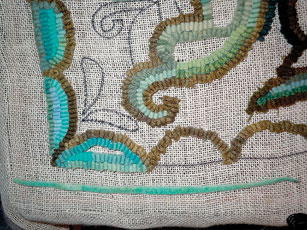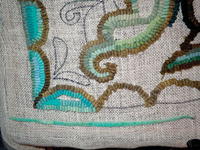The Tapered Wide-Cut Strip
Tips and techniques from an expert: help your loops behave in an orderly fashion

Here's an example of tapering a measured strip on both ends to fill a creascent shipped area.
When I began rug hooking many years ago, I was struck by the beauty of how the repetitive rows of wide-cut loops provided such a strong directional quality to the overall composition of a rug. It gave rugs movement and vibrancy, as rows of background echoed motifs or as long radially placed rows accentuated the sharp points of a star. As I hooked more and more, I also became more sensitive (some say neurotic!) about preserving this important directional quality in all areas of my rugs.
Early on, I was told to turn a wide-cut loop sideways to make it fit into narrow spaces, and this trick served me well in my earlier rugs. However, the more I hooked and improved my technique, the more my frustration grew at having to squeeze a too-wide loop into a narrowing space. So, in my neurotic determination to preserve a continuity of loop direction and avoid a cramming approach to hooking, I realized that the only way I was going to avoid these uneven spaces was to hook a striped rug—and really, how many striped rugs would I want to hook anyway?
This article is from the January/February 2012 issue. For more information on our issues, check out our issues page.



